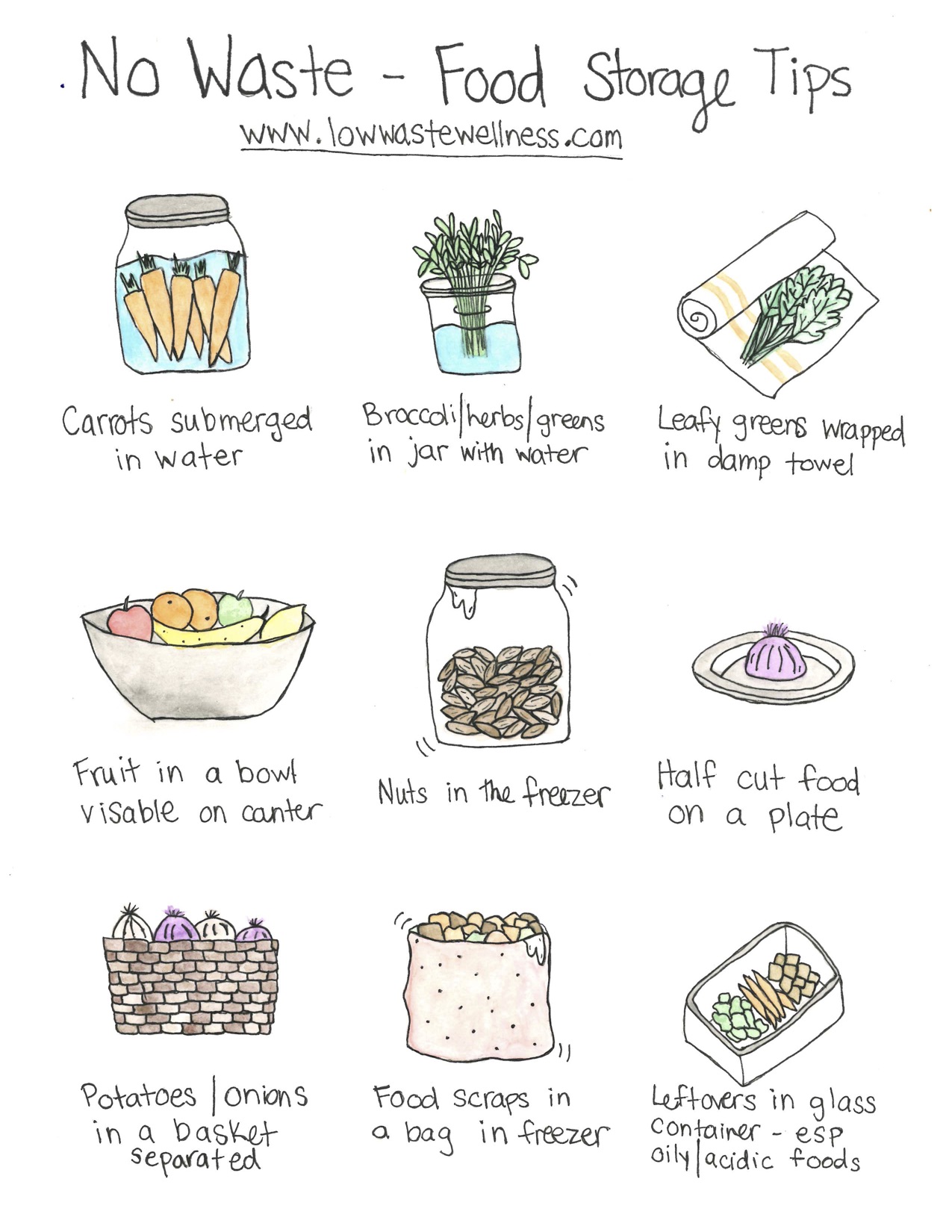No Waste - Food Storage Tips
Sadly, 40% of the food we produce is wasted from farm to fork. (1,2) That’s nearly half of the food we grow and harvest is lost to farmers, distributers, sellers, consumers, and most importantly, our Earth. The worst part is instead of composting the wasted food, we – even most farmers - often just toss the food away into landfills creating methane gas, which is more potent than carbon dioxide emissions (3). Although each member of the food system contributes to food waste, we consumers are the biggest culprits (3). This comes from our own lack of planning and improper storing of all the precious, nutritious food we buy and eat, so how can we reduce food waste?
Since we are the biggest contributors to food waste, we are also the most effective solution. If we can better understand how to properly store our food to reduce food waste, we can become part of the solution. This blog post shows you 9 simple food-storage tips to help you reduce food waste saving you both time and money. Along with this blog post, download and share the pdf-flyer No-Waste Food-Storage Tips at the bottom of this post . Stick it on your fridge, share with your friends, put it on your work bulletin board so you and others can learn and refer back to these guidelines designed to save us all.
9 No-Waste Food Storage tips
Print it, post it, share it, use it!
Here are 9 food-storage tips to help you save time, money, and most importantly reduce food waste.
Submerge carrots in water.
This also goes for other similar root vegetables like, radishes or parsnips. Submerging these vegetables in water retains the water in the carrots and keeps them crisp and fresh for up to a month. It’s also important to change the water every 3 or 4 days to retain optimal freshness. Another tip is to cut them up so they are ready and available for quick snacks.
Keep herbs, broccoli, or leafy greens in a cup of water.
This tip is my favorite! Have you ever bought a bunch of cilantro or parsley, put it in your fridge, and the next day it is limp and near death? That’s happened to me too many times, but this tip is a cilantro saver! Take your herb, leafy greens, or broccoli, cut off the bottom, and place in a jar with water similar to how you would keep a bouquet of flowers fresh. The cilantro will lasts two weeks or more! The key is to make sure to cut the ends off so the greens can suck up the water to stay fresh. Also, change the water every 3 or 4 days to retain optimal freshness.
Wrap leafy greens up in a damp towel.
This works great for any type of leafy green or herb. Just take a damp kitchen towel, wrap the greens in it, and place it in your crisper drawer, or in your fridge. This works similarly to storing carrots, radishes, and parsnips. By keeping the leafy green roots moist in a container of water, keeps them fresher and crisper.
Place fresh fruit in a bowl out on a table.
Studies have shown that when food is visible, people are much more likely to eat it (4). Thus, keeping your fruit out for all to see instead of stashing it away in the pantry or in the fridge significantly increases fruit not going to waste. This also applies in reverse for unhealthy foods. Stash less healthy foods away in a drawer or a cupboard, and we are much less likely to eat them as frequently.
Put nuts and seeds in the freezer.
If you don’t eat nuts and seeds frequently, put them in the freezer. Since nuts and seeds are packed with healthy oils, they should be stored in the freezer to preserve their precious oils from going rancid. This also applies to other foods such as fruit at the end of its life. Either eat it up right away, or put it in the freezer and use it later for smoothies or desserts, giving it an additional life.
Store half-cut food on a plate.
If you have food, such as an onion, potato, zucchini, or really any food that is cut in half, you can place it on a plate with the cut-side down to keep the cut-side from spoiling faster. This method avoids buying, using, and landfilling plastic wrap. You could also use reusable bee-wax wraps, but keeping the cut-side down on a plate is cheaper and easier.
Store onions and potatoes separately in a basket.
Do not store them together because the onions give off ethylene gas, increasing the ripening process of potatoes, spoiling them more quickly. Store the two similarly, both covered in a dark cool place and typically in a basket to give ventilation but a glass or metal container would work as well. Also, cover the baskets with a kitchen towel since light can also speed up the ripening process.
Keep veggie scraps in a bowl or bag in the freezer.
Instead of composting your veggie scraps, store them in your freezer to make veggie scrap broth. To make the broth, place all the scraps in a pot, cover them with water, bring to a boil, and then let simmer for 30 minutes. Strain and compost the veggies and you’ll be left with a free delicious broth with no packaging needed. Food-scrap broth definitely is a great way to give our scraps and our wallets more life.
Keep leftovers in glass containers.
You don’t need to immediately throw out your current plastic containers but slowly switching to glass is better for our health and environment since plastic leaches harmful chemicals into our food and eventually our environment (5). This is especially the case for oily or acidic foods as these foods absorb the chemicals in plastic more easily (5). An additional tip is to bring a glass container, like mason jars, when going out to eat. Instead of using a restaurant container to take food home, put leftovers in a clean glass container. Saving food and money and reducing plastic and waste preserves us all.
My hope is these no-waste food-storage tips help us significantly reduce our food waste, saving time and money, but most importantly, save our Earth. The state of our planet is very fragile, and each action we take to reduce our personal and environmental impact truly matters.
References

